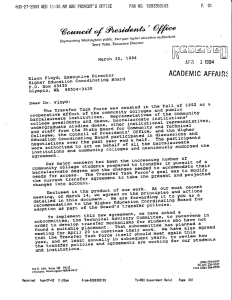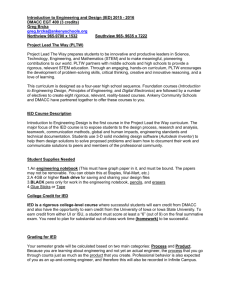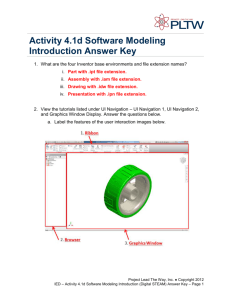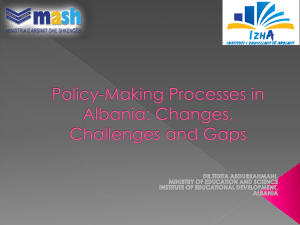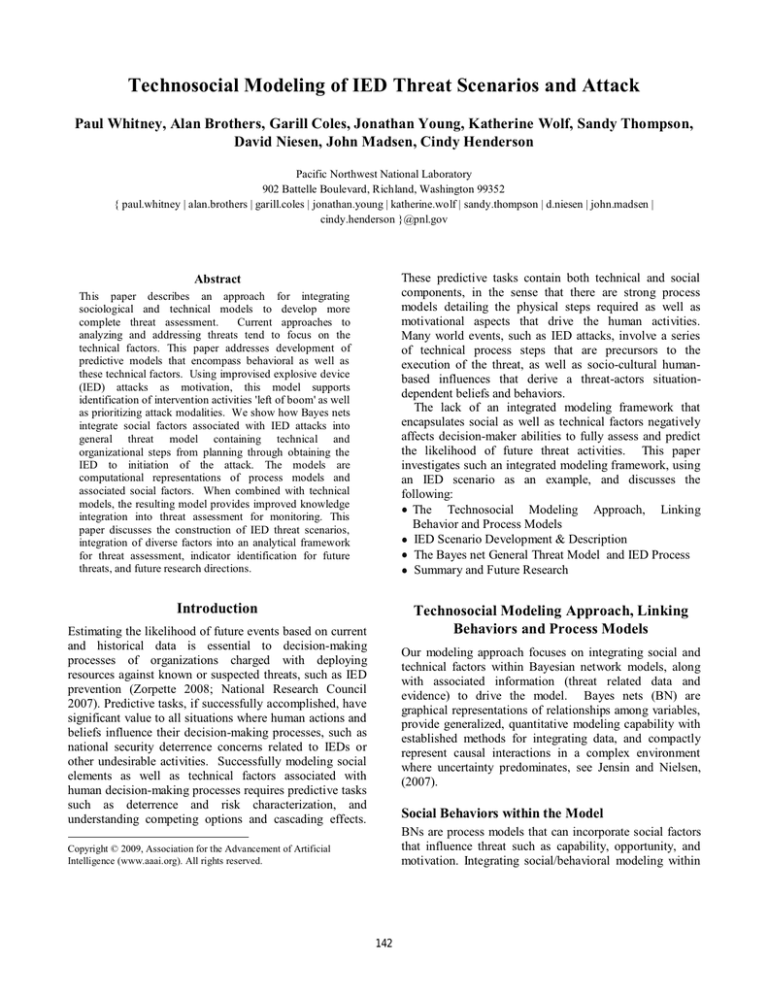
Technosocial Modeling of IED Threat Scenarios and Attack
Paul Whitney, Alan Brothers, Garill Coles, Jonathan Young, Katherine Wolf, Sandy Thompson,
David Niesen, John Madsen, Cindy Henderson
Pacific Northwest National Laboratory
902 Battelle Boulevard, Richland, Washington 99352
{ paul.whitney | alan.brothers | garill.coles | jonathan.young | katherine.wolf | sandy.thompson | d.niesen | john.madsen |
cindy.henderson }@pnl.gov
These predictive tasks contain both technical and social
components, in the sense that there are strong process
models detailing the physical steps required as well as
motivational aspects that drive the human activities.
Many world events, such as IED attacks, involve a series
of technical process steps that are precursors to the
execution of the threat, as well as socio-cultural humanbased influences that derive a threat-actors situationdependent beliefs and behaviors.
The lack of an integrated modeling framework that
encapsulates social as well as technical factors negatively
affects decision-maker abilities to fully assess and predict
the likelihood of future threat activities. This paper
investigates such an integrated modeling framework, using
an IED scenario as an example, and discusses the
following:
The Technosocial Modeling Approach, Linking
Behavior and Process Models
IED Scenario Development & Description
The Bayes net General Threat Model and IED Process
Summary and Future Research
Abstract
This paper describes an approach for integrating
sociological and technical models to develop more
complete threat assessment.
Current approaches to
analyzing and addressing threats tend to focus on the
technical factors. This paper addresses development of
predictive models that encompass behavioral as well as
these technical factors. Using improvised explosive device
(IED) attacks as motivation, this model supports
identification of intervention activities 'left of boom' as well
as prioritizing attack modalities. We show how Bayes nets
integrate social factors associated with IED attacks into
general threat model containing technical and
organizational steps from planning through obtaining the
IED to initiation of the attack. The models are
computational representations of process models and
associated social factors. When combined with technical
models, the resulting model provides improved knowledge
integration into threat assessment for monitoring. This
paper discusses the construction of IED threat scenarios,
integration of diverse factors into an analytical framework
for threat assessment, indicator identification for future
threats, and future research directions.
Introduction
Technosocial Modeling Approach, Linking
Behaviors and Process Models
Estimating the likelihood of future events based on current
and historical data is essential to decision-making
processes of organizations charged with deploying
resources against known or suspected threats, such as IED
prevention (Zorpette 2008; National Research Council
2007). Predictive tasks, if successfully accomplished, have
significant value to all situations where human actions and
beliefs influence their decision-making processes, such as
national security deterrence concerns related to IEDs or
other undesirable activities. Successfully modeling social
elements as well as technical factors associated with
human decision-making processes requires predictive tasks
such as deterrence and risk characterization, and
understanding competing options and cascading effects.
Our modeling approach focuses on integrating social and
technical factors within Bayesian network models, along
with associated information (threat related data and
evidence) to drive the model. Bayes nets (BN) are
graphical representations of relationships among variables,
provide generalized, quantitative modeling capability with
established methods for integrating data, and compactly
represent causal interactions in a complex environment
where uncertainty predominates, see Jensin and Nielsen,
(2007).
Social Behaviors within the Model
BNs are process models that can incorporate social factors
that influence threat such as capability, opportunity, and
motivation. Integrating social/behavioral modeling within
Copyright © 2009, Association for the Advancement of Artificial
Intelligence (www.aaai.org). All rights reserved.
142
technical process models should improve threat likelihood
modeling and traditional decision-making processes by
enabling decision makers to account for the variety of
uncertainty associated with various model components.
The IED scenario and model (described below) provide
a preliminary application focus through which the research
team can test the integrated modeling hypothesis. The
demonstration integrated BN threat model includes
technical and social components and processes, detailing
the physical steps leading up to an IED event, as well as
the motivational aspects that drive human activities,
supporting likelihood assessments.
We developed representations and linkages between
behavior and process (technical) models, IED scenarios,
and inferences and examples. IED’s were selected based
on the potential impact to a target (infrastructure), the fact
that they represent simple attacks (simple to model), while
from a social/behavioral perspective, IED’s as an attack
tool include numerous motivational elements that are
challenging to model.
A precursor to modeling IED attacks was constructing a
realistic scenario. The general ingredients of a scenario,
with examples, include who (insurgency, religious or
political extremists), what (selection of one or more
explosive materials), where (specific geographic location),
when (date/time, perhaps associated with a preceding
observational event), why (the desired outcome), and how
(the method of attack execution). Scenarios need not be
long or complex, so long as they contain the critical
elements necessary for a modeling framework. After
identifying the critical elements for an IED scenario, a
notional example scenario was developed:
Why Bayesian nets
BNs are a powerful and well-developed technology that
can potentially provide insight and predictive capability
from the social aspect of the social-technical interaction.
We base the quantification of the likelihood of events
within a combined behavior and process model on
probability calculus. This mathematical formalism
provides the framework to combine the two probabilities
(technical and social) into an overall probability of a
successful execution of a single IED attempt:
Group X has the objective of repelling and limiting
the efficiency of a well-armored occupying force in
order to preserve the sanctity of their way of life from
the corrupting influences of the occupying force. This
group has access to a wide variety of demolitions and
explosives as well as experts in employing them,
having had many of their members trained in military
service and universities across the world. To send a
message to the occupying forces, a low-level recruit
places an IED in a roadside mailbox – well aligned to
target a passing vehicle, on a route frequently
traveled by the occupiers. After placing the device,
an observer remains nearby to set off the charge at
the appropriate time when a target vehicle passes the
mailbox (detonation in this case done by command
wire) and to also record the attack for effects analysis
and future training, motivational, propaganda, and
recruitment purposes.
P(Successful IED) =
P(Successful IED | Attempt ) * P( Attempt)+
P(Successful IED| no Attempt) * P(no Attempt)
= P(Successful IED | Attempt ) * P( Attempt).
Where the last equality follows from:
P(Successful IED| no Attempt) = 0.
IED Scenario Development & Description
IED attacks are possible anywhere in the world because
they are effective weapons that are relatively cheap to
procure or construct and can be as simple or complex as
the people that employ them. Scenario characteristics are
outlined in Walker (2006 – see slide 3), and Magness
(2005 - see Figure 2). Although the characteristics of IEDs
vary with time, geography, and technology, the
overwhelming preponderance of IEDs have one mutual
trait - they are the culmination of a networked effort.
Additionally, since the materials and capabilities for IEDs
are widely available, and since the rate of occurrence of
IEDs varies – there is a strong suggestion that social and
behavioral factors are the critical drivers for IED
occurrence and rates.
IED networks can be as varied as the IEDs they employ
from small isolated groups to loose associations of action
cells and large, highly structured organizations.
Motivations vary across the process – potentially ranging
from personal (revenge), criminal (monetary objectives), or
ideological. However, the common attribute of every IED
network is the threat they present, and by dissecting that
threat, the technical and social dimensions of IED
networks can be examined.
The Bayes Net General Threat Model and
IED Iteration
A model designed to represent generic threats was
constructed – see Figure 1 for a representation of this
model in the GeNIe (2008) software. The model is general
in the sense that the elements/components are relevant to
IEDs but are also the criteria considered for other threats;
see Paté-Cornell and Guikema(2002) for a similar model.
The model computes relative risk across scenarios based
on currently available information and predicts scenario
occurrences.
This General Threat Model (GTM) is a Bayes net
representation of the relationship among these concepts
contributing to an overall threat – Motivation, Capability
143
and Target Characteristics. Grey boxes are critical concepts
for understanding threats. The black represents risk, and
white represents consequence. Technical aspects in the
model are represented in capabilities and in the
consequence parts of the models. Social aspects are
captured in the Motivation & Intent and the Target
Selection nodes. This model (and similar models) provides
a view that integrates over a period of time. This particular
model is constructed to reflect that motivation and intent
can provide the drives to seek capabilities.
Perception of Vulnerability: This component considers
whether the group believes they can gain access to the
target.
S&E Knowledge: The group’s access to the fundamental
Scientific and Engineering knowledge to execute a
specific threat scenario. This could be decomposed into
various compartments related to understanding,
constructing, and delivering devices, sufficient to carry
out the threat.
Capability for Scenario: Whether the group has the
capability to execute the threat, based on the
contributions of contributing indicators.
Success of Scenario: The likelihood of success, given
threat and opportunity, and measures the extent to which
the group objectives are achieved.
Equipment: The gear necessary to handle, process, and
weaponize the material (for example, beakers, test tubes,
personal protective equipment, etc.).
Operational: Planners (thought / group leadership) and
resources (people, money) required for executing an
attack scenario.
Material: Any raw materials that contribute to a terrorist
attack tool. For a bio-threat, this could be anthrax
spores, or E. coli samples, or hoof & mouth slurry. For
an IED, it would include the trigger and explosive. For a
chemical threat, it could be the chemical, or a set of
precursor chemicals.
The model constituents within Figure 1 include:
Violent Scenario Likelihood: This component represents
the probability of a specific scenario, conditionally based
on intent, the target accomplishing the intent goal, and
the capability to accomplish the goal.
Motivation and Intent:
The degree to which an
organization or individual is motivated to execute
biological terrorism, including contextual as well as
intrinsic information.
Target fits Group Goals: This component considers, for
example, whether the successful execution of a scenario
against a specific target advances the group’s agenda and
is consistent with group ethics.
Target Select: The perception of vulnerability associated
with a potential target and whether it’s a factor in the
threat, as (presumably) an attack would be made only if
success against the selected target was possible.
Figure 1. General threat model
144
The threat model results in a calculation of the
likelihood of the scenario being successfully executed.
Note – without calibrating the model against empirical
observations, the primary utility of this calculation is to
compare the relative likelihoods of distinct scenario
variations to be successfully carried out. The likelihoods
are multiplied against the consequences to estimate a risk.
Risk is equal to likelihood×consequence. For this effort,
consequence has three components, measure of human
harm in terms of causalities or mortality, the economic
cost, and the sociological/psychological consequences
from implementation of the scenario. Risk has the same
three corresponding dimensions. Relative risk assessment
includes estimation of probabilities or likelihoods
associated with each scenario as well as estimation of the
consequences from implementing the scenario.
The model in Figure 1 is an interesting ‘meso-scale’
view of threats. To understand what is being aggregated,
we develop and compare this model with a more detailed
IED threat model. Figure 2 depicts the IED process model.
This notional process model (Figure 2) is based on a
variety of resources (Magenss 2005, Walker 2006,
National Research Council 2007, Zorpette 2008). This
process model shows an IED attack as a number of explicit
steps. These steps includes obtaining funding and bomb
materials, recruiting people, constructing the device,
selecting the target, delivering the device to its target,
carrying out the attack, and escaping. The steps in the
process model are roughly sequential except that in the
early stage the obtaining of human, financial physical
resources can occur in parallel and are interdependent. All
of the steps of the process have logical connections to other
steps and the ultimate degree and likelihood of success is
based on the outcome of each step. As recognized by a
variety of researches – BNs can be used to represent
process models (e.g. see Bobbio et al 1999). We take
advantage of this to represent the IED process in GeNIe –
as shown in Figure 2.
Distinct groups with their distinct motivations can
potentially play across the process shown in Figure 2. A
group with a political agenda might be driving the planning
and/or finance (steps 1 and 2). A group (or individuals)
with financial motivations might be engaged in placing the
IEDs (step 12). At each step of the process – there must be
willing and capable individuals to carry the process
forward.
Contrasting the models – the primary perspective for the
GTM is that there is a single driving organization, and that
part of the necessary capabilities and resources are other
people or organization to carry out the steps in the process
model.
Figure 2. IED process model
Detection Model
The process model lays out the sequence of steps required
to carry out an IED attack. Making explicit the activities
involved in carrying out an attack is the first step in the
development of a detection model. While the GTM can be
used to evaluate scenarios based on relative risk, the
process model provides insight into the activities necessary
to execute the threat. This model can be augmented to
(potentially) support detection and associated interventions
to disrupt the process. The detection model can be used by
analysts monitoring specific groups to detect the intent to
carry out an attack and assesses the imminence of that
attack.
Figure 3 shows how the process model can be
augmented to support detection. Directly-observable
indicators are connected to indicators (steps) in the process
145
model. In particular – the figure shows – for one of the
nodes (Step 9) in the process model some of the types of
observable indicators that may be relevant to showing that
the scenario is in progress. The particular observables are
related to new people, faces and physical changes in a
potential IED site. Other steps in the process have their
associated observable indicators.
Any number of indicators could be associated with each
of the nodes in Figure 2. Of particular interest within the
IED process model are those nodes that have clear
social/behavioral elements:
Plan the Attack: This node requires one or more
“mastermind planners” that are joined by one or more
levels of social fabric that unites them in a common
cause to attack.
Obtain Finances:
Resourcing an attack requires
monetary funds or some other tangible item of value that
the planners can acquire to finance their activities.
Financial and contractual exchanges generally are
accompanied by some type of transactional trail that
contains multiple levels of human involvement.
Recruit Personnel: How do the attack planners attract
and retain like-minded individuals, or at least individuals
whose circumstances dictate that they accept
questionable employment. Are participants willing or
unwilling?
Obtain Materials:
IED attacks require numerous
components such as but not limited to explosive
materials. These materials must be obtained through
some type of supply network that involves humans,
transportation, and financial/contractual exchanges.
Summary and Future Research
The IED models addressed in this paper consist of three
elements: 1) a general threat model 2) a process model, and
3) a detection layer on the process model. The process
model represents a technical model. The other two models
start to model the associated human element. These
models, when provided with data, provide likelihood
information for outcomes (e.g., the relative likelihood of
each IED attack scenario in a threat model) or a measure of
imminence for the detection model (e.g., how likely is it
that a particular activity in the IED process model is being
carried out based on human activity).
Topics for our future investigations focus on validation
and information integration. A key point for validation of
models is that each of the models is based on 10’s to 100’s
of parameters. This characteristic (a large number of
parameters) is shared by other approaches in computational
technosocial modeling, be it Systems Dynamics, Agent
Modeling etc. To estimate and/or empirically validate a
model with that number of parameters requires
independent data on the order of a multiplier of the number
of parameters. So, doing a case study on a particular group
can be viewed as ‘1’ observation. There are databases of
observations that can be used to validate aspects of some of
the models developed for DHS. This aspect of the work is
ongoing. Another key point for validation is that the
models are of a mathematical form (Bayes networks) that
they can be empirically validated. Even better, if we have
models for the same broad phenomena from distinct, and
perhaps competing, papers, and if data are available to
validate these models, an assessment can be made of which
model fits the data better.
In addition to empirical observations, the type of
information commonly brought to bear on graphical
models is (expert) opinions. Opinions are used as inputs for
the form of model construction and for the probability
parameters. In addition to how to most effectively elicit the
information, there are issues of combining information
from multiple opinion providers, and how to weight or
combine that information with direct empirical
observations.
Finally, each of the models, the meso-scale model
represented in Figure 1 and the more detailed process
model in Figure 2, are presented and calculate without
explicitly considering the context. For instance, the group
engaged in retrieving finances for a particular scenario
might at the same time be engaged in obtaining finances
for a number of scenario events. The area of placement for
attacks might be influenced by social or technical factors,
such as the willingness of local populace to report IED
placement and ease of surveillance observation based on
physical conditions and available technology. A critical
next step is placing such models in context.
Figure 3. Observable Indicators related to the IED process model
The detection ‘mode’ of the process model is meant to
be used by intelligence analysts for monitoring whether the
particular IED scenario is underway. The model has been
quantified with conditional probabilities that give
reasonable behavior first approximation behavior.
146
References
Bobbio, A., Portinale, L., Minichino, M., and Ciancamerla,
E. 1999. Comparing Fault Trees and Bayesian Networks
for Dependability Analysis. In Proceedings of the 18th
international Conference on Computer Computer Safety,
Reliability and Security M. Felici, K. Kanoun, and A.
Pasquini, Eds. Lecture Notes In Computer Science, vol.
1698. Springer-Verlag, London, 310-322.
Committee on Defeating Improvised Explosive Devices:
Basic Research to Interrupt the IED Delivery Chain, 2007,
Countering the Threat of Improvised Explosive Devices:
Basic Research Opportunities, National Research Council.
http://www.nap.edu/catalog.php?record_id=11953
GeNIEe & SMILE
http://genie.sis.pitt.edu.
[Web
Page].
Available
at:
Jensen, Finn V. and Thomas D. Nielsen, 2007, Bayesian
Networks and Decision Graphs, Second Edition. Springer,
New York.
Magness, Thomas H. “IED Defeat: Observations from the
National Training Center” Engineer: The Professional
Bulletin of the Army Engineers Jan-Mar 2005. 28-31.
http://www.wood.army.mil/ENGRMAG/PDFs%20for%20
Jan-Mar%2005/Magness.pdf
Paté-Cornell, M.E. and S.D. Guikema. “Probabilistic
Modeling of Terrorist Threats: a Systems Analysis
Approach to Setting Priorities Among Countermeasures,”
Military Operations Research, Vol. 7, No 4, December
2002
Walker, Starnes – Presentation delivered to the AAAS
Forum
on
Science
and
Technology
Policy.
http://www.aaas.org/spp/rd/Forum_2006/walker.pdf
Zorpette, Glenn “Countering IEDs”, IEEE Spectrum.
September 2008; 26-35.
147


